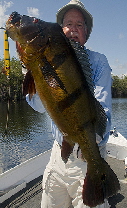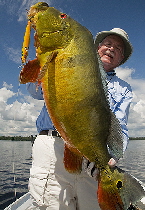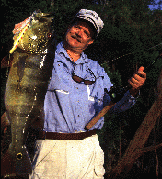|
Excitement in the Amazon
The World's Greatest Gamefish swims in South American waters
by Larry Larsen
The peacock bass by nature is aggressive and its personality is downright belligerent. It is a fish so powerful that it can destroy tackle, straighten hooks and
tear the hardware right out of hardwood and plastic baits. The fiercest fighting fish in the world will smash and mangle lures, even break them apart, and then give you the battle of your
life.
 It is impossible to exaggerate the strike and fight of this colorful gamefish. The larger it gets, in contradistinction to its North American cousins, the
better it fights. The fish almost always jumps the second they are hooked, and after ahead-shaking leap or two, they make an
incredible run. Even a four- or five-pounder can wear a person out, and they probably grow to over 30 pounds! It is impossible to exaggerate the strike and fight of this colorful gamefish. The larger it gets, in contradistinction to its North American cousins, the
better it fights. The fish almost always jumps the second they are hooked, and after ahead-shaking leap or two, they make an
incredible run. Even a four- or five-pounder can wear a person out, and they probably grow to over 30 pounds!
In a long, straight run, the aerial acrobat weighing over 15
pounds can rip 40-pound test line from a heavy-duty 3:1 ratio casting reel with the drag clamped down tight. The trophy-size peacock can easily break 20- to 30-pound test monofilament or
straighten out a 3X heavy-strength hook in one of its initial charges or when it sees the boat and senses doom.
What makes an angler whose favorite fish is the musky,
smallmouth bass, striper, or giant largemouth dream of another species? What would make a snook or tarpon guide give up on them to chase after a
freshwater species? It's the fish that is head and shoulders above all the others in this world: the peacock bass. Imagine a 12-Megaton hydrogen bomb going off below your
topwater plug or giant popper.
There is no such thing as a pot-bellied peacock bass. Its splashy colors make it
virtually impossible to sneak up on its forage, so if it can't catch the food, a peacock goes hungry. As a result, a giant peacock is just as quick as a smaller fish ...and a lot more powerful.
The fighting ability of the peacock puts them at the head of the class. Pound for
pound, it is the toughest-fighting freshwater gamefish in the world. With the exception of the tuna family, the peacock bass, I believe, is the top battler in global waters of any
salinity. When you consider the jumping ability, the power, the attitude and the excitement generated by large peacock bass, no other fish even comes close.
Their Deadly Range
 These fish originate and thrive in the same South American waters of two dreaded species: the piranha and the powerful payara. The blood-hungry
piranha grow to five or six pounds and the devilish saber-toothed payara maxes out at over 30. Any fish that can hold its own
where these and other hellacious predators live has to be tough. Peacock bass are among the 1,800 other species that have been cataloged from the Amazon home waters. These fish originate and thrive in the same South American waters of two dreaded species: the piranha and the powerful payara. The blood-hungry
piranha grow to five or six pounds and the devilish saber-toothed payara maxes out at over 30. Any fish that can hold its own
where these and other hellacious predators live has to be tough. Peacock bass are among the 1,800 other species that have been cataloged from the Amazon home waters.
Fortunately, the range of the peacock bass has grown substantially. Today, you can fish for them in three places -
Florida, Hawaii and Puerto Rico - without even needing a passport. The fish can be found in Panama, and I'm told by good authority
, Costa Rica in Central America. The biggest of these bruisers, though, still live in South America. Venezuela, Brazil and Colombia harbor the most giant peacocks, and other countries,
such as Guyana, Surinam, French Guiana, Ecuador, Peru and Bolivia, have waters that contribute to the massive Amazon watershed which abounds with peacock bass.
The peacock is not really a "bass" at all. The two fish similar in stature and sporting
qualities are genetically far apart. The peacock, which has attained documented weights in excess of 26 pounds, is called bass because it strongly resembles a
largemouth in general size and shape. However, it is actually the largest American member of the cichlid family of fishes which also includes the guapote ("rainbow bass")
, oscar, and tilapia, among many others.
While conducting research on the fish for my book, "Peacock Bass Explosions," I
found out that there are 1,400 species of the cichlid family in the world and 250 to 300 in South America. The family is to tropical waters as the sunfish family, which
includes the black basses, is to temperate fresh waters of North America. Some biologists believe that the two were derived from a common ancestor, a prehistoric saltwater perch.
General Description
Once you see the fish, you'll understand why it is called a peacock bass by most
North Americans. The peacock bass derives its name from the large conspicuous, ocellated (ringed in gold) black mark on its tail, which resembles the vivid "eye" on the
beautiful plume of a peacock's tail. Hence the name, "peacock bass." The distinctive gold-embroidered circular black halo spot on all peacock bass tails reminds some more
of the savage eye of a jungle cat.
 The prominent "false eye" on the tail is actually a deceptive target for predators.
Most all fish have a black eye on their heads, and some have evolved physically one or two ways to "misguide" an attack to the eye area from predators. One common
evolution is the eye spot near the rear of the fish. Another is color patterns that obscure the eye or detract from its prominence. The peacock bass has both a false
eye on the tail, and vivid and irregular color patterns on the head. The prominent "false eye" on the tail is actually a deceptive target for predators.
Most all fish have a black eye on their heads, and some have evolved physically one or two ways to "misguide" an attack to the eye area from predators. One common
evolution is the eye spot near the rear of the fish. Another is color patterns that obscure the eye or detract from its prominence. The peacock bass has both a false
eye on the tail, and vivid and irregular color patterns on the head.
The rainbow-like coloration of the peacock bass is striking; the colors rival many
saltwater coral reef fish. It generally has a dark greenish-black or bronze back and a light white belly with rear underside that ranges from golden to mellow yellow or light
chartreuse to pink or blood red. It normally has a main body background area of green, yellow, burnished gold or dark black hues and irregular broad and dusky black
vertical bars along its sides.
Gill covers, tail and fins on the lower half of the body (pelvic and anal fins) are subtly
-splashed with traces of hues that widely vary from bronze to bright orange to pink to crimson red to a greenish yellow. The pectoral fins are not colored. Colors on the
lower gill plate, however, can be vivid. Black splotches (patterned like random ink spots) abound on the gill covers (near the eye) of the speckled peacock. Dorsal fins
may be a translucent aquamarine or bluish-gray, as can be the top half of the tail fin.
Add to the above their always striking scarlet or blood red (iris) eyes that stare you down when the fish is mad as hell at you, and you will have the complete picture, as
words can describe such.
Let's Play The Name Game
Several species within the genus Cichla are commonly referred to as peacock bass.
Some biologists, literature and/or tour operators contend that there are five distinct species of the colorful peacock, others three or four, and still others say there could be
, in fact, a dozen species. One biologist, in fact, reportedly claims there are perhaps two dozen species of peacock. Exactly how many species of the colorful peacock
there really are depends on which biologist you speak with.
The common English name, peacock bass, is derived by Americans from the
common Spanish name, "pavon" (which means peacock). "Pavon" is derived from "pavo real." In Venezuela, the pavon is the national fish of the country. The fish is
also called "tucunare" (from a Tupi Indian/Portuguese dialect, pronounced "too-coon-array") in Brazilian, Panamanian and Hawaiian waters, and "lukanani" in Guyana waters.
 The fish, as I found out in numerous trips fishing for the
species, are similar to largemouth in many ways. They have similar habits and habitat preferences and are caught on similar lures. The ways they are less similar makes them even more
exciting. They are tougher, meaner and slightly bigger. They feed only during daylight hours. As a schooler, peacocks are more like the saltwater dolphin. The fish, as I found out in numerous trips fishing for the
species, are similar to largemouth in many ways. They have similar habits and habitat preferences and are caught on similar lures. The ways they are less similar makes them even more
exciting. They are tougher, meaner and slightly bigger. They feed only during daylight hours. As a schooler, peacocks are more like the saltwater dolphin.
Most fish roam in schools, but the peacock bass is known for roaming in gangs. The peacock bass is something of a thug. A
hooked fish triggers the others in the school to search and destroy prey of their own. Leaving a hooked fish in the water until a second one nearby is hooked will prolong the excitement.
I call it the "World's Greatest Gamefish" because it is attracted to cover, strikes topwater lures regularly, jumps when hooked, never gives up a battle, is powerful
enough to tax angler skills and tackle, breaks line and lures easily, has a physical appearance that looks exciting, and obtains an average size of 15 to 25 pounds (a very respectful weight).
Editor's Note: This article is a partial excerpt from the book, "Peacock Bass Explosions". The longer book chapter contains additional information on how-to catch
the exciting fish and where they can be found throughout the world. For more information on peacock bass check out our website www.peacockbassassociation
.com
|